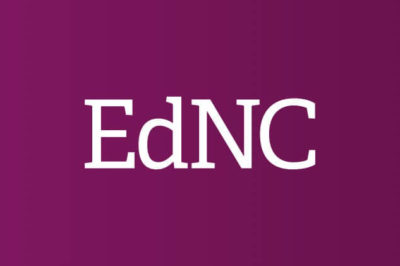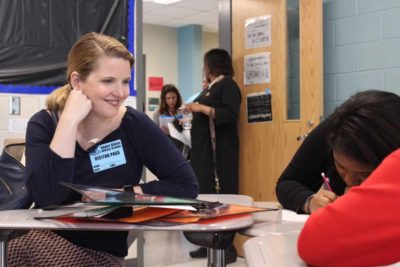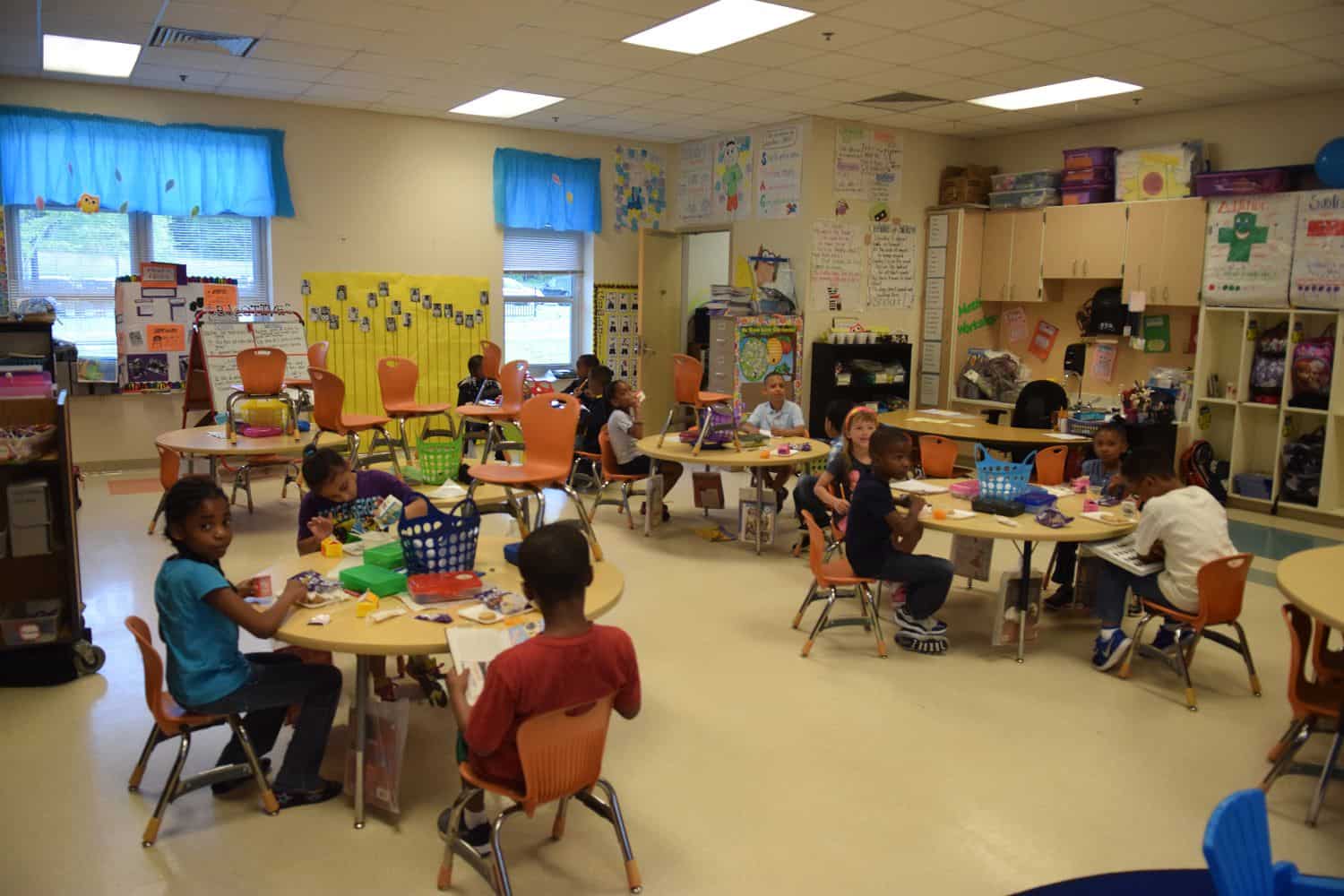Former teacher James Hogan caught the attention of national media outlets last week with his inflammatory proclamation that North Carolina is waging a step-by-step war on public education. As education advocates who believe our state has the potential to have the best education system in the nation, we were dismayed.
There is no disagreement that education in our state faces many challenges, and we undoubtedly have a long way to go to provide every student with an outstanding education that helps them reach their full potential.
But opinion articles that oversimplify this complex issue are the real war on North Carolina’s education system, demoralizing dedicated educators and communities that have endured tough economic times and are working hard to deliver a high quality education for all students.
North Carolina’s flatlining academic performance did not begin in 2012 and cannot be placed on the shoulders of one party, one administration, or one set of state policies. Today’s education system has been decades in the making and is a product of the changing dynamics of economies and populations. It is imperative that we understand these complexities if we are to work together to find effective solutions that will make our education system the best in the nation. We cannot do this with over-simplification built on half-truths and which incites a polarized dialogue.
As Hogan points out, North Carolina is facing declining interest in the teaching profession, and has been for several years, but so is nearly every other state in the nation. The implication that North Carolina’s decline is the direct result of eliminating the Teaching Fellows program deliberately ignores the fact that the program only prepared about three percent of the 10,000 teachers North Carolina hires every year.
More blatantly false, Hogan claims that the Fellows program “produced droves of quality teachers who filled hard-up school classrooms.” In fact, the program’s own sponsoring organization transparently reported, “Teaching Fellows taught in schools and classrooms with greater concentrations of higher-performing, lower-poverty students… Fellows today tend to be clustered in the larger metropolitan areas where teacher recruitment overall has historically been less problematic.” Building on this knowledge, the current NC House budget includes funding for an updated teacher scholarship program that would graduate up to 1,000 teachers each year—specifically for the state’s hardest-to-staff schools and subject areas.
Perpetuating more myths, Mr. Hogan mentions the oft-cited anecdotes of public school teachers fleeing North Carolina for higher paying jobs in other states, implying—without evidence—a direct link to policy changes made in the past few years. In fact, the state’s own data show that only three percent of teachers who left their classrooms in 2014 moved to another state. That is half a percent lower than the number of teachers who found work in other states in 2008.
On teacher salaries, we agree that more work is needed. North Carolina educators went as much as five years—many of those under previous administrations—without any pay raises. This has left teacher pay in a decades-long hole that will take several years to reverse. But the current leadership took a big step forward with last year’s pay increase that averaged seven percent (not the $270, claimed in the blog) and this year, both current House and Senate budgets recommend an additional pay increase averaging four percent. This is real progress. We encourage our elected officials to continue this progress toward getting teacher pay to where it needs to be.
Not mentioned in the blog, but at least as important as teacher salaries, is the quality of North Carolina’s school leadership. Survey after survey shows that teachers care about pay, but they care even more about the quality and preparation of the leader they work for, just like other professionals. After years of scant attention to principal leadership, the General Assembly this year has proposed a $10M investment in principal preparation that would significantly raise the bar on what we expect of and provide for school leaders. If approved, the program would prepare potentially hundreds of principals for North Carolina public schools every year.
Perhaps most significantly, Mr. Hogan marginalizes the importance of student achievement by mocking school letter grades and not once mentioning academic achievement. In truth, there are schools in North Carolina that have as few as 5 percent of students meeting proficiency—a fact that is far more profound and worthy of media attention than a purported war on education based on half-truths. These academic disparities have existed for far longer than one political cycle. North Carolinians need to know this fact and use it as a call to action in support of public education.
Rather than pointing fingers, we encourage our fellow North Carolinians to do what we do best—work proactively and collaboratively to find solutions that will elevate educators to the status they deserve. In addition to a commitment to raise teacher pay, a powerful proposal is on the table right now with House and Senate budget negotiators. The plan offers a comprehensive approach to elevate teachers and principals by recruiting, preparing, developing, and supporting great educators so they can focus on what matters most to them and to us—our students. This is the antithesis of a “war” on public education and the most-likely antidote to persistently low-performing schools.
It is time to stop pointing fingers and start looking for solutions to real problems.
We owe our children a public discourse that models the collaboration, respect, and optimism that we hope they will exhibit as adults.
We also owe educators a vision for a productive path forward, one that values their contributions and engages them as the highly skilled professionals they are.
Let’s solve these problems together and leverage the incredible potential of our state to provide our children the best education system in the nation.
Fact Check: James Hogan’s blog post, as quoted in the Washington Post
North Carolina business leaders understand that great solutions to complex problems are built on difficult, respectful conversations and diverse perspectives. We don’t shy away from constructive disagreements—but we also don’t shy away from the facts. A fact-check of a Mr. Hogan’s most concerning points is included below.
“Among their first targets: … cuts to public schools, including laying off thousands of teachers…The state lost thousands more teacher and teacher assistant positions.”
- We don’t know where Mr. Hogan finds evidence for the layoff of thousands of teachers. The North Carolina Statistical Profile from the Department of Public Instruction shows that in 2008, North Carolina had 97,676 teachers. Since 2008, the largest decline in the number of teachers employed in North Carolina was between 2011 and 2012, when the state employed 641 fewer teachers. There is no evidence that teachers were laid off; rather, it is more likely that vacant positions remained unfilled. In 2012, the state hired an additional 1,357 teachers and since then, the number of teachers has grown to 98,988 in 2014.
- Error of omission: while Teacher Assistants were mentioned four times in the blog, the proposed reduction in student-to-teacher ratios in Kindergarten through grade three to as low as 15 students per teacher was not mentioned once.
“Two years later, in the last budget cycle, 2014-15, the legislature provided roughly $500 million less for education than schools needed.”
- Hogan’s own source, PolitiFact, rated this claim “Half-True.”
“In fact, by 2014-15, North Carolina was still spending $100 million less on public education than it had before the economic recession.”
- North Carolina is spending more today on public education than it did before the economic recession, even when adjusted for inflation. The public education appropriation for the 2014-15 school year is $11,013,800,000—a significantly higher number than the $9,406,300,000 allocated in 2007, just before the Great Recession. When adjusted for inflation, North Carolina is also spending more per pupil now than in any of the ten previous years, with the exception of 2009, a peak budget year.
“And when Republicans finally acted to increase teacher pay, they claimed to make the biggest pay hike in state history–but in reality only bumped up paychecks by an average of $270 per year.”
- We find no evidence that supports Mr. Hogan’s claim that the teachers received on average a $270 increase in salary. The average salary for a North Carolina teacher in 2013, the year before the raise was added, was $44,990. If you multiply this number by the average percent raise, 6.9 percent (according to calculations from Fiscal Research), teachers received on average an additional $3,104 dollars on their annual paycheck, plus benefits.
- In 2014, the General Assembly passed an average 6.9 percent raise for teachers. This year, both the House and the Senate have proposed additional teacher raises averaging 4 percent. Combined, this nearly 11 percent average raise makes significant progress toward addressing the 17.4 percent decline (adjusted for inflation) in salaries teachers experienced between 2003 and 2013.
“Meanwhile, Texas and Virginia started actively recruiting North Carolina teachers to go work in their states. It didn’t take much to convince Tarheel teachers to flee…”
- Relatively few North Carolina teachers are leaving to teach in other states, and rates have been relatively consistent since the economic recession. The North Carolina Department of Public Instruction’s 2014 Teacher Turnover Report reports that the percentage of teachers leaving for other states rose slightly in 2014 (734, or 5.4 percent) with fewer leaving (341, or 3.5 percent) in 2012, consistent with the rate in 2008 (467, or 3.5 percent).
“The Teaching Fellows program produced droves of quality teachers who filled hard-up school classrooms.”
- Most Teaching Fellows did not teach in hard-to-staff areas of North Carolina. In the Public School Forum’s Teaching Fellows Report from earlier this year, the Forum reported that “Teaching Fellows taught in schools and classrooms with greater concentrations of higher-performing, lower-poverty students” and “tend to be clustered in the larger metropolitan areas where teacher recruitment overall has historically been less problematic than in the state’s poorer and rural districts.”
“The Teaching Fellows program…budget was a modest one, and yet Republicans uprooted it from the state budget and killed the entire program. The result? Enrollment in teacher prep programs in the UNC system has dropped 27 percent in the last five years.”
- The number of students in UNC system education programs reached a peak in 2010, but it has declined since. This decline started while Democrats were in office and cannot be solely attributed to the actions of a Republican-led legislature or the elimination of the Teaching Fellows program.
- Hogan implies that the decreased enrollment in teacher programs is the direct result of the elimination of the Teaching Fellows program. However, the program only prepared about three percent (3%) of the 10,000 teachers North Carolina hires every year.
“More than 700 of the state’s public schools (nearly thirty percent) received a score of D or F. Many parents struggled to understand how so many schools could so quickly fail. But instead of demonstrating the quality of a school, the state’s new grading measure much more accurately described the socio-economic status of its enrolled students–nearly every one of the state’s “failing” schools were considered high-poverty schools.”
- Using ‘growth’ as an alternative measure, which is not based on socio-economic status, there are 591 schools across the state that are failing to meet growth. These schools did not ‘so quickly fail’—these schools were failing for a very long time, but remained virtually ignored. While the current letter grades are an imperfect measure (there are 86 D and F schools that exceeded growth, for example), we hope these grades will compel North Carolina to take a positive, comprehensive approach to improving public schools.
“We’re five weeks overdue on the budget, and some legislators are saying the budget might not be settled until Labor Day.”
- In the past 15 years, North Carolina has passed a budget on-time just four times, and two of those were on the final day of the fiscal year. We still haven’t approached the 88 extra days it took in 2001 or the 92 days it took in 2002. We agree with Mr. Hogan that passing a budget after the beginning of the school year does not benefit schools or students. But what matters more is whether the final approved budget results in a better budget for education.
Editor’s Note: BEST NC supports the work of EdNC.
This article was corrected on August 17, 2015:
Original:
- Relatively few North Carolina teachers are leaving to teach in other states, and fewer are leaving now than before the economic recession. The North Carolina Department of Public Instruction’s 2014 Teacher Turnover Report reports that only 455 left for this reason in 2014—just three percent of the 13,616 teachers who left their jobs last year. The percentage of teachers “fleeing” to other states was actually higher before the recession, as 3.5 percent of teachers in 2008 left to teach in other states.
Correction:
- Relatively few North Carolina teachers are leaving to teach in other states, and rates have been relatively consistent since the economic recession. The North Carolina Department of Public Instruction’s 2014 Teacher Turnover Report reports that the percentage of teachers leaving for other states rose slightly in 2014 (734, or 5.4 percent) with fewer leaving (341, or 3.5 percent) in 2012, consistent with the rate in 2008 (467, or 3.5 percent).
Recommended reading




